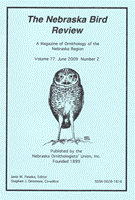Nebraska Ornithologists' Union

Nebraska Bird Review
Date of this Version
2-2019
Document Type
Article
Citation
The Nebraska Bird Review, Vol. 87 No. 1 (2019), pp 3-14
Abstract
As has been the trend in recent winters, and despite the relative coolness of this winter, there were numerous examples of species north of expected midwinter ranges or present in higher numbers than usual in winter. The long list includes unexpected midwinter records of Tundra Swan, American Wigeon, Ring-necked Duck, Lesser Scaup, White-winged Dove, Sandhill Crane, Clark’s Grebe, Doublecrested Cormorant, Red-shouldered Hawk, and Yellow-bellied Sapsucker. Startling was the state’s first winter record of Sedge Wren, perhaps the biggest rarity of the season. And Eastern Meadowlark was documented in midwinter for the first time, although its presence in the southeast has been suspected. Record winter counts were made of Mallard (124,000), Common Merganser (20,000-31,000), Eurasian Collared- Dove (1500), and American Goldfinch (342). Trends of concern are the continuing decline of Black-billed Magpie and new indications of problems with Black-capped Chickadee and even possibly Tufted Titmouse. On the positive side, Greater Prairie-Chicken is doing well in the northeast and Barred Owl is sprinting westward in the Republican River Valley. Very low numbers of Common Redpoll and Red Crossbill are probably cyclically-related, as might be the virtual absence of Gray Partridge and Pinyon Jay the last couple of years. The winter was devoid of rarities, the best being the aforementioned winter Sedge Wren, Black Rosy-Finch, two Varied Thrushes, and a Dark-eyed (Pink-sided) Junco documented for the east.
Included in
Ornithology Commons, Population Biology Commons, Poultry or Avian Science Commons, Zoology Commons


Comments
Published by the Nebraska Ornithologists’ Union, Inc.